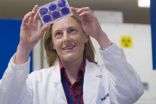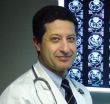(Press-News.org) A stack of punch cards from a landmark study published in 1966, and the legwork to track down the study's participants years later, has yielded the longest analysis of the effects of lipoproteins on coronary heart disease.
The study, published in a recent issue of the journal Atherosclerosis, tracked almost 1,900 people over a 29-year period, which is nearly three times longer than other studies that examine the link between different sizes of high-density lipoprotein particles and heart disease.
It found that an increase in larger high-density lipoprotein particles decreased a subject's risk of heart disease. The research also underscores the value of looking to the past to advance science.
"Often we think only of designing new studies with the latest technologies, but there are treasures buried in our past," says study author Paul Williams of the U.S. Department of Energy's Lawrence Berkeley National Laboratory.
Lipoproteins are fat molecules that carry cholesterol in the blood. Cholesterol is divided into high-density lipoprotein, the so-called good cholesterol, and low-density lipoprotein, the bad cholesterol.
That's common knowledge today. But it was a groundbreaking and controversial notion in the 1950s, when Berkeley Lab's John Gofman used an analytic ultracentrifuge at Berkeley Lab to separate and measure the different lipoproteins. He was the first to propose that high-density and low-density lipoprotein particles play a role in heart disease.
His research was met with skepticism, however, so Gofman began a prospective study of lipoproteins in a group of 1,905 employees at Lawrence Livermore National Laboratory between 1954 and 1956. After ten years, there were 38 new cases of heart disease. In 1966, he reported that men who developed heart disease had lower levels of the HDL2 (the larger high-density lipoprotein particles) and HDL3 (the smaller high-density lipoprotein particles).
It would take several more years for Gofman's work to gain currency in the scientific community. Gofman left lipoprotein research in the 1960s to pioneer the study of the biological effects of low doses of radiation. He died in 2007.
His Livermore cohort study collected dust until 1988, when Williams discovered the study's punch cards at the University of California, Berkeley's Donner Hall. Realizing he had found an epidemiological goldmine, Williams verified the cards' authenticity by examining logbooks. He also found an old punch card machine to extract their data. Then, with the help of students and research assistants, he located and contacted 97 percent of the people in Gofman's study over the next nine years.
"Often, all we had to go on was an address on a street that no longer existed," says Williams, a staff scientist in Berkeley Lab's Life Sciences Division. "Women had changed their names, employees had left or retired and moved, and many had died. However, by telephoning neighbors and coworkers, we were able to track down all but a few."
Medical records were obtained and reviewed by a physician, Daniel Feldman, who is the study's co-author.
Their 29-year follow-up uncovered 363 cases of coronary heart disease. They found that both HDL2 and HDL3 lowered heart disease risk, and that a one-milligram per milliliter increase in HDL2 produced a significantly larger reduction in coronary heart disease risk than a one-milligram per milliliter increase in HDL3. Their follow-up also buttressed Gofman's insights from 1966.
"Gofman's original conclusion that ischemic heart disease is inversely related to both HDL2 and HDL3 was upheld in the current analyses," says Williams, who hopes to complete the 55-year follow-up of this cohort.
INFORMATION:
The research was funded with grants from the American Heart Association and the National Institutes of Health's National Institute on Aging.
Lawrence Berkeley National Laboratory is a U.S. Department of Energy (DOE) national laboratory managed by the University of California for the DOE Office of Science. Berkeley Lab provides solutions to the world's most urgent scientific challenges including sustainable energy, climate change, human health, and a better understanding of matter and force in the universe. It is a world leader in improving our lives through team science, advanced computing, and innovative technology. Visit our website.
Additional information:
Williams' study, "Prospective study of coronary heart disease vs. HDL2, HDL3, and other lipoproteins in Gofman's Livermore Cohort," was published online Oct. 23, 2010, in the journal Atherosclerosis.
Gofman's 1966 study,"Ischemic heart disease, atherosclerosis and longevity" was published in the journal Circulation, 1966;34:679-697
END
Walter and Eliza Hall Institute researchers in Melbourne, Australia, have discovered how a key viral gene helps viruses evade early detection by the immune system. Their finding is providing new insights into how viruses are able to establish chronic infections, leading scientists to reevaluate their approaches to viral vaccine development.
Researchers from the institute's Immunology division together with collaborators at the University of Cambridge (UK) have been studying how the immune system responds to viruses that cause persistent or chronic infections and why ...
ST. PAUL, Minn. –Women who have multiple sclerosis (MS) are more likely to have a gene associated with multiple sclerosis than men with the disease and it is this gene region where environment interacts with the genetics, according to a study published in the January 5, 2011, online issue of Neurology®, the medical journal of the American Academy of Neurology.
Research has shown that the number of people diagnosed with MS has been rising, and the rate has been rising faster for women than for men.
The cause of MS is not known, but evidence suggests that it is triggered ...
CHAPEL HILL, N.C. – A pair of clinical trials, conducted in part at the University of North Carolina at Chapel Hill, found that two weeks of treatment with rifaximin provides significant relief of irritable bowel syndrome symptoms including bloating, abdominal pain and loose or watery stools.
In addition, the studies found that the benefits of treatment with rifaximin (brand name: Xifaxan) persisted for 10 weeks after patients stopped taking the broad-spectrum antibiotic, said Yehuda Ringel, MD, an associate professor of medicine in the UNC School of Medicine and a co-author ...
LOS ANGELES (EMBARGOED UNTIL 5 PM ET on JAN. 5, 2011) – A ground-breaking antibiotic therapy developed at Cedars-Sinai Medical Center is the first potential drug treatment to provide irritable bowel syndrome patients with long-lasting relief of their symptoms even after they stop taking the medication, according to a study published in the Jan. 6 issue of the New England Journal of Medicine.
Unlike in traditional therapies, such as when taking antidepressant and other medications that have benefits only while on the drug, patients in the study reported relief of their ...
10-Dec 2010 What happens when galaxies crash together? For years, these cosmic collisions have been blamed for triggering violent outbursts at the hearts of galaxies. Now, a remarkable piece of detective work has given a verdict: galactic mergers do not usually whet the appetite of the black holes that power these active galactic nuclei, meaning other, less dramatic phenomena are responsible.
Most galaxies, including our own, have a huge but well-behaved black hole at their heart, while some have messy eaters that suck in vast amounts of matter which then shines brightly ...
This new infrared image of the Lagoon Nebula was captured as part of a five-year study of the Milky Way using ESO's VISTA telescope at the Paranal Observatory in Chile. This is a small piece of a much larger image of the region surrounding the nebula, which is, in turn, only one part of a huge survey.
Astronomers are currently using ESO's Visible and Infrared Survey Telescope for Astronomy (VISTA) to scour the Milky Way's central regions for variable objects and map its structure in greater detail than ever before. This huge survey is called VISTA Variables in the Via ...
AT A GLANCE
The Infectious Diseases Society of America (IDSA) released its first-ever guidelines for the treatment of methicillin resistant Staphylococcus aureus (MRSA), which will help physicians determine the most appropriate care for infections due to the common bacterium.
MRSA is the most common cause of skin infections that send people to the emergency room. Its invasive form kills about18,000 people a year.
Treatment of MRSA varies widely. The guidelines will help physicians make good treatment decisions, which may mean not prescribing antibiotics for some ...
[EMBARGOED FOR JAN. 5, 2011] Two doses of the varicella, or chickenpox, vaccine provide excellent protection in children against this highly contagious and, in some cases, severe disease. To be published in the February 1 issue of The Journal of Infectious Diseases, the findings support the two-dose vaccine regimen recommended in the United States since 2006. (Please see below for a link to the study online.)
The Centers for Disease Control and Prevention (CDC) began recommending a single dose of varicella vaccine in children aged 1 to 13 years old in 1995. Although the ...
Encouraging new evidence suggests that the bulk of the world's fisheries – including small-scale, often non-industrialized fisheries on which millions of people depend for food – could be sustained using community-based co-management.
"The majority of the world's fisheries are not – and never will be – managed by strong centralized governments with top-down rules and the means to enforce them," according to Nicolas Gutiérrez, a University of Washington doctoral student in aquatic and fishery sciences who is lead author of a paper that goes online Jan. 5 in the journal ...
RIVERSIDE, Calif. – The conventional view of the history of the Earth is that the oceans became oxygen-rich to approximately the degree they are today in the Late Ediacaran Period (about 600 million years ago) after staying relatively oxygen-poor for the preceding four billion years. But biogeochemists at the University of California, Riverside have found evidence that shows that the ocean went back to being "anoxic" or oxygen-poor around 499 million years ago, soon after the first appearance of animals on the planet, and remained anoxic for 2-4 million years. What's more, ...




